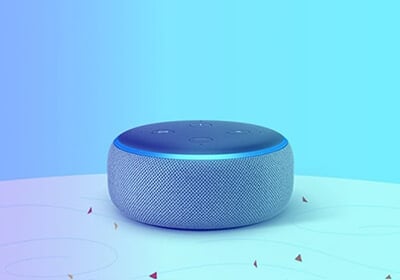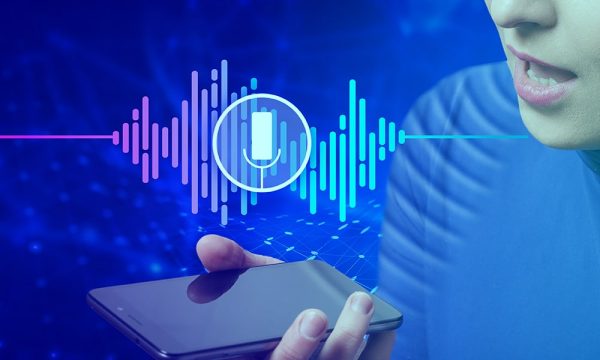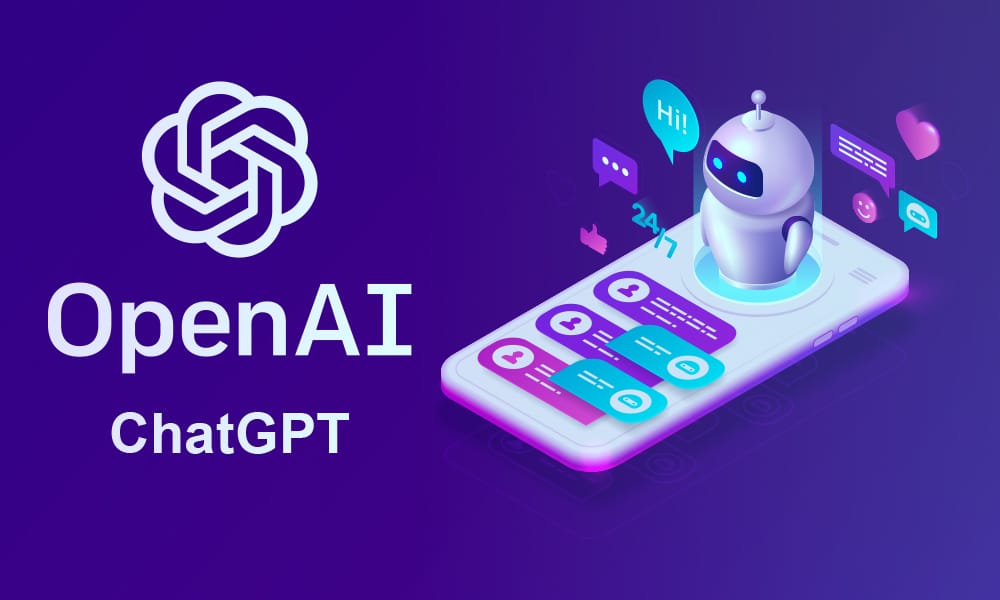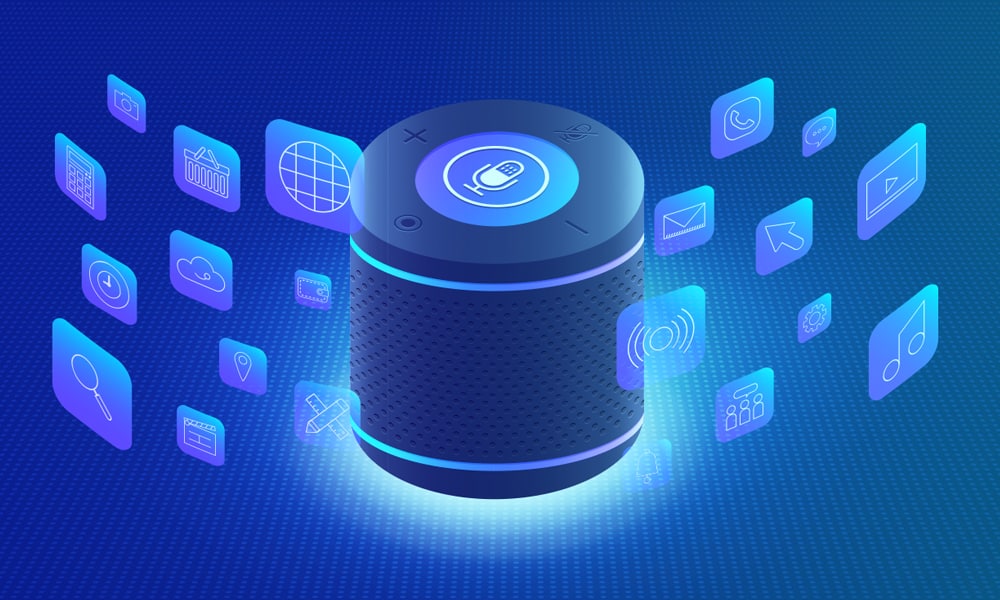Market Size: In less than 20 years, voice recognition technology has grown phenomenally. But what does the future hold? In 2020, the global voice recognition technology market was about $10.7 billion. It is projected to skyrocket to $27.16 billion by 2026 growing at a CAGR of 16.8% from 2021 to 2026.
What is Voice Recognition and Speech Recognition Technology and Why You Need It?
Voice recognition, otherwise known as speaker recognition, is a software program that has been trained to identify, decode, distinguish and authenticate the voice of a person based on their distinct voiceprint.
The program evaluates a person’s voice biometrics by scanning their speech and matching it with the required voice command. It works by meticulously analyzing the frequency, pitch, accent, intonation, and stress of the speaker. Voice recognition systems analyze a person’s speech to identify unique vocal traits, providing authentication and security for access and transaction authorization.

Voice recognition has grown tremendously over the past few years. Intelligent assistants such as Amazon Echo, Google Assistant, Apple Siri, and Microsoft Cortana perform hands-free requests such as operating devices, writing notes without using keyboards, performing commands, and more. These systems rely on spoken commands to interact with users and provide a voice user interface (VUI) that enables voice access for hands-free productivity.
How Does Voice Recognition Work?

Audio Input: The process begins with capturing the audio input using a microphone.
Preprocessing: The audio signal is cleaned up by removing noise and normalizing the volume.
Feature Extraction: The system analyzes the audio to extract key features such as pitch, tone, and frequency.
Pattern Recognition: The extracted features are compared to known patterns of speech stored in a database.
Language Processing: The recognized patterns are converted into text, and natural language processing (NLP) algorithms interpret the meaning.
Voice Recognition – Advantages & Disadvantages
| Advantages of Voice Recognition | Disadvantages of Voice Recognition |
| Voice recognition allows multitasking and hands-free comfort. | While voice recognition technology is improving by leaps and bounds, it is not completely error-free. |
| Talking and giving voice commands is much faster than typing. | Background noise can interfere with the working and impact the reliability of the system. |
| The use cases of voice recognition are expanding with machine learning and deep neural networks. | The privacy of the recorded data is a matter of concern. |
History of Voice Recognition?
The journey of voice recognition technology began in the 1950s with the development of the first speech recognition systems, which could only identify a handful of simple words and phrases. These early efforts laid the groundwork for future advancements, as researchers sought to expand the capabilities of recognition systems. By the 1970s and 1980s, the introduction of statistical models and machine learning algorithms marked a significant leap forward, allowing speech recognition systems to handle more complex language and improve their accuracy.
A major milestone was reached in the 1990s with the advent of speaker-independent systems, which could recognize speech from multiple users without requiring individual training. This breakthrough made voice recognition technology more accessible and practical for everyday use. Over the past decade, the field has been transformed by the rise of deep learning and the availability of large, diverse datasets. These innovations have enabled voice recognition systems to achieve unprecedented levels of accuracy and versatility, powering everything from virtual assistants and smart speakers to mobile apps and transcription services. Today, voice recognition technology continues to evolve, driven by ongoing research in machine learning and artificial intelligence..
[Also Read: What is ASR (Automatic Speech Recognition): Everything a Beginner Needs to Know ]
Voice Recognition vs. Speech Recognition
Here’s a table summarizing the differences between voice recognition and speech recognition:
| Aspect | Voice Recognition | Speech Recognition |
| Purpose | Identifies and authenticates the speaker | Recognizes and transcribes spoken words |
| How It Works | Analyzes unique vocal characteristics such as pitch, frequency, and accent to match the voice with a known voiceprint | Uses algorithms to convert spoken language into written text, focusing on understanding the content of the speech |
| Use Cases | Security systems, personalized user experiences, biometric authentication | Virtual assistants, dictation software, transcription services, command and control systems |
| Focus | Who is speaking | What is being said |
| Example Technologies | – Voice Assistants: Used for personalized responses and various tasks – checking the weather or making reservations. – Hands-free Calling: Allows users to make calls to specific contacts handsfree. – Voice Biometrics: Used in financial services for secure user verification. – Voice Picking: Employed in warehouses to help workers complete tasks hands-free. | – Note Taking/Writing: Platforms like Google’s speech-to-text engine and Siri enable voice-to-text translation, commonly used in apps like Apple’s Notes. – Voice Control: It allows users to control devices via voice commands, such as directing a car’s infotainment system. – Assisting the Disabled: It aids the deaf, hard of hearing, and those with disabilities through auto-captioning, Dictaphones, and text relays. |
Voice Recognition Use cases
Voice recognition technology has a wide range of applications across various fields. Here are some key use cases:

- Security and Authentication:
- Biometric Authentication: Used in smartphones and other devices to unlock screens and verify user identity.
- Access Control: Secures access to buildings, secure areas, and confidential information by recognizing authorized personnel.
Voice Recognition Products: Examples include smart home devices and security systems that use voice recognition for hands-free control and enhanced security.
- Personalized User Experience:
- Virtual Assistants: Customizes responses and actions based on the user’s voice, providing a more personalized interaction.
- Smart Home Devices: Recognizes different family members’ voices to tailor settings and preferences for each individual.
- Voice Typing: Used as a productivity tool for data entry and automation, improving efficiency and accuracy in various environments.
- Customer Service:
- Call Centers: Identifies customers by their voice, enabling personalized service and reducing the need for repetitive identity verification.
- Banking: Verifies customers during phone banking transactions for secure and efficient service.
- Speech-to-Text Software: Converts spoken language into written text, improving efficiency, customer service, and accuracy in communication.
- Healthcare:
- Patient Authentication: Confirms patient identity in telehealth services and electronic health records.
- Voice Biometrics for Monitoring: Monitors patients with conditions like depression by analyzing changes in voice patterns.
- Doctor’s Virtual Assistant: Converts doctor speech to text notes allowing the doctor to see and analyze more patients during the day.
- Third-Party Applications: Medical assistants and healthcare tools integrate voice recognition for enhanced functionality.
- Automotive:
- In-Car Systems: Recognizes the driver’s voice to adjust preferences, access navigation, and control infotainment systems without manual input.
Handsfree experience: Answer phone calls, change the song, reply to messages or get direction without having to leave the steering wheel; this not only increase saftey on the road but also offers better driving experience.
- Legal and Forensic:
- Voice Identification: Used in legal investigations to identify speakers in audio recordings.
- Security Surveillance: Enhances security measures by identifying individuals through voice in surveillance systems.
- Court Reporting: Advanced voice recognition is used for accurate legal transcription during court hearings and depositions, improving efficiency and accuracy over traditional court reporting methods.
- Entertainment:
- Gaming: Personalizes gaming experiences by recognizing players’ voices.
- Media Devices: Identifies users to customize content recommendations and profiles on streaming devices.
- Telecommunications:
- Secure Communication: Ensures secure communication channels by verifying the identity of participants in confidential calls.
Voice Interfaces: Enable natural, conversational interactions in generative AI and smart devices, making user experiences more intuitive.
Multiple Devices and Mobile Devices: Voice recognition technology functions seamlessly across multiple devices, including mobile devices and Android phones, supporting productivity and user experience on the go.
Recognition Software Work: Modern recognition software work by supporting different languages, offering multilingual support, and providing compatibility with mobile devices and various platforms for voice control.
Voice Recognition Software Work: Voice recognition software work across different platforms, support multiple languages, and integrate with third party applications for enhanced functionality.
Support for Different Languages: Modern voice recognition systems can switch between different languages, dialects, and accents, making them versatile for global use.
Example of Voice Recognition Technology

- Apple Siri: Imagine having a witty, knowledgeable friend in your pocket, always ready to help. That’s Siri for you. Whether you’re rushing to a meeting and need to send a quick text, or you’re elbow-deep in cookie dough and need to set a timer, Siri’s there, recognizing your voice and responding with a touch of personality. It’s like having a personal assistant who knows you so well, they can almost finish your sentences.
- Amazon Alexa: Picture walking into your home after a long day and saying, “Alexa, I’m home.” Suddenly, your favorite relaxation playlist starts playing, the lights dim to your preferred evening setting, and Alexa reminds you about that show you’ve been meaning to watch. It’s like your home gives you a personalized, comforting hug every time you return.
- Google Assistant: Think of Google Assistant as your all-knowing buddy. Whether you’re wondering about the weather, need to settle a friendly debate, or want to control your smart home, it’s there, recognizing your voice and tailoring its responses just for you. It’s like having a super-smart friend who’s always excited to help and never gets tired of your questions.
- Nuance Dragon NaturallySpeaking: Imagine being able to pour your thoughts onto paper as fast as you can speak them. That’s the magic of Dragon NaturallySpeaking. For a novelist crafting their next bestseller or a doctor updating patient records, it’s like having a super-efficient, never-tiring transcriber who understands every word, accent, and nuance in your voice. It’s not just typing – it’s liberating your thoughts.
- Microsoft Cortana: Cortana is like having a personal organizer who’s always one step ahead. Picture yourself on a hectic Monday morning, and Cortana chimes in: “Based on your voice, you sound a bit stressed. Shall I reschedule your less urgent meetings for later this week?” It’s not just about managing your schedule; it’s about having a digital ally who understands the nuances in your voice and helps make your day smoother.
Future of Voice Recognition
The future of voice recognition is set to be shaped by rapid advancements in artificial intelligence, machine learning, and deep learning, promising even greater accuracy and efficiency. One of the most exciting trends is the expansion of multilingual support, allowing recognition systems to understand and respond to speech in multiple languages and dialects. This capability will make voice recognition technology more accessible and useful to a global audience.
[Also Read: Conversational AI: How it’s works, Example, Benefits and Challenges ]
As voice recognition continues to evolve, its adoption in emerging markets is expected to accelerate, helping bridge the digital divide and providing new opportunities for access to information and services. The integration of voice recognition with IoT devices, smart homes, and smart cities will enable seamless, voice-driven interactions between people and technology, making everyday tasks more intuitive and efficient.
Looking ahead, the convergence of voice recognition with other cutting-edge technologies—such as computer vision and augmented reality—will open the door to innovative applications and user experiences. As recognition systems become more intelligent and versatile, voice recognition will play an increasingly central role in shaping the way we interact with the digital world.
Frequently Asked Questions (FAQ)
1. What is voice recognition?
Voice recognition, also known as speaker recognition, is a technology that identifies and authenticates individuals based on their unique voice characteristics.
2. How is voice recognition different from speech recognition?
Voice recognition identifies who is speaking, while speech recognition focuses on what is being said. Voice recognition analyzes vocal biometrics, whereas speech recognition converts spoken words into text.
3. What are the main applications of voice recognition?
Key applications include security and authentication, personalized user experiences, customer service, healthcare, automotive systems, legal and forensic uses, and entertainment.
4. Is voice recognition secure for authentication purposes?
Voice recognition can be highly secure, but like any biometric system, it’s not infallible. It’s often used as part of multi-factor authentication for enhanced security.
5. What are some popular examples of voice recognition technology?
Popular examples include Apple’s Siri, Amazon Alexa, Google Assistant, Microsoft Cortana, and Nuance Dragon NaturallySpeaking.
6. How does voice recognition impact privacy?
Privacy concerns exist around the collection and storage of voice data. It’s important for companies to be transparent about their data practices and offer user controls.
7. Can voice recognition work in multiple languages?
Yes, many voice recognition systems are designed to work across multiple languages and accents.








